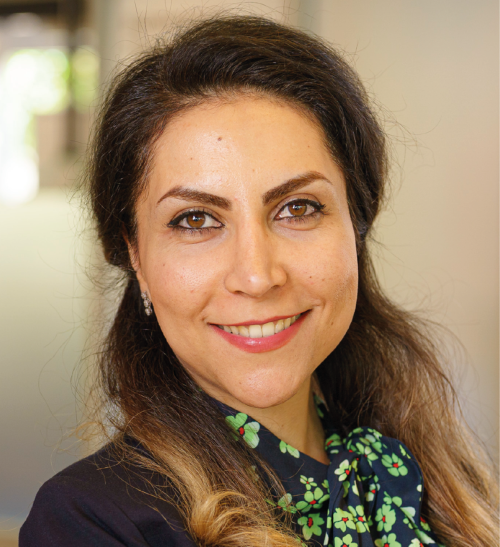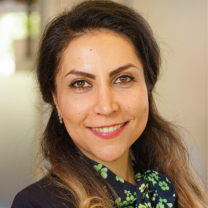Meet our Energizer! Hanieh Bazyar
Originally from Iran, Hanieh Bazyar has been working and living in the Netherlands since 2015. After earning her PhD at the University of Twente, she took up a postdoctoral position in the Process and Engineering Department of the Faculty of Mechanical Engineering at TU Delft in 2020.
At the end of her one-year post doc position, Hanieh was promoted to Assistant Professor and in 2023 she continued her work at the Chemical Engineering Department of the Faculty of Applied Sciences of TU Delft. Here she develops her research group on novel membrane and separation processes.
Working with membrane innovation, Hanieh develops cutting-edge technologies to transform how essential resources are captured, filtered, and separated. Her work spans (waste)water treatment, anion exchange membranes for clean energy (green hydrogen), and electrochemical carbon capture, all designed to enhance efficiency and sustainability.
Hanieh: “Currently, I am involved in four projects that illustrate how I try to enhance performance of existing membranes, develop novel separation-sensing microfluidics, and high-performance anion exchange membranes (AEMs), contributing to the energy transition. My research work will eventually enable green hydrogen production, reduce industrial emissions and advance circular water systems.”

Picture: Marcel Krijger
Adaptive membranes for smart filtering and separation
During her PhD project, Hanieh worked on membranes for oily wastewater treatment. The next generation membranes she developed, have adaptive pores, meaning that these membranes can adjust their properties in response to changing conditions, such as pressure, temperature or the type of contaminants in the water. This makes membrane-based water treatment more energy-effective due to prevention of membrane fouling.
Hanieh’s expertise is novel materials for separation processes, to enhance the separation efficiency. In her group, Hanieh and her team members address the shortcomings of the current membranes, such as fouling, by developing smart stimuli-responsive membranes.
Hanieh explains: “I develop these materials by synergy of various scientific disciplines. Membranes with actuators, for example, can vibrate to mitigate fouling. To design these membranes, you have to bring together expertise in sensing and actuators technology. I approach colleagues in these fields to help me further develop the work.”
Another exciting project is about separation and sensing microfluidic functions of membranes. Microfluidics is like a very tiny plumbing system, consisting of small channels with diameter in the range of micrometre. The project aims to develop a separation-sensing platform using stimuli-responsive microgels and chip-based membranes. This platform will enable real-time detection and analysis of key substances, such as dissolved carbon dioxide in seawater. In this project, Hanieh works closely together with colleagues from the University of Alberta, Canada.
Engineering membranes for clean hydrogen
Collaboration is a central theme of Hanieh’s approach to work. With industry, she also works together with professionals in the development of anion exchange membranes. This project has the goal to improve green hydrogen production by electrifying the process of splitting water molecules into oxygen and hydrogen. To electrify this process a special membrane is developed that allows negatively charged ions to move efficiently between two electrodes. The better the ionic conductivity, the more effectively negative ions can flow through the system, preventing energy loss.
In hydrogen production, electricity and water are required, the latter of which competes with drinking water. Additionally, a membrane is necessary. These membranes are expensive, which makes membrane-based water electrolysis for green hydrogen production more costly than the current state-of-the-art hydrogen production process (steam methane reforming). Therefore, there is a need to develop highly conductive ion exchange membranes to avoid energy penalties.
Electro-chemical carbon capture
Last but not least, Hanieh works also on electrochemical carbon capture. Hanieh explains: “We develop a material called redox-active carriers for electrochemical carbon capture.” The redox-active carrier is a special molecule that can adsorb carbon dioxide in a specific state, while it releases carbon dioxide in another state. It can be used for carbon capture from the air, or from industrial exhaust gases, such as flue gas.
Hanieh continues: “Once the carrier is electrochemically reduced at the cathode, it contains negative charge, which can capture carbon dioxide. Later, at the anode the carrier can be reset, releasing the carbon dioxide for storage and reuse, while the redox-active carrier also can be reused. I find this a promising way to reduce emissions from industry, helping the transition toward a more sustainable society!”
Electrifying the carbon capturing process is a promising technology to tackle the current carbon dioxide emissions and fits the general trend in society towards electrifying appliances. It’s a novel approach for carbon capture, says Hanieh. She continues: “Captured carbon can be used directly in carbon dioxide electrolysers to be converted to chemicals such as hydrocarbons. In this way the capture and conversion are both electrified processes, making it into a plug-and-play platform.”
Collaboration is key
Hanieh’s experience of working with other disciplines began during her PhD, both within and outside University of Twente. She had a collaborative approach from the outset, which continued in Delft. Hanieh says this is also why she chose an academic career, as it allows her to explore and collaborate with others, from whom she learns a great deal.
Hanieh: “These projects came about through opportunities presenting themselves, where I could propose ideas and also search for experts to complement my own work. For example, I have been collaborating with the University of Alberta in Canada and David Vermaas at the TU Delft.”
Let a positive attitude prevail over disappointment and stress
Hanieh’s work is experimental, which means dealing with uncertainty: equipment failures, unexpected results, and challenges beyond her control. She encounters this often, especially in BSc and MSc projects. Her approach? To stay positive. “We always find a way around it,” Hanieh says.
With students, she focuses on exploring problems from different angles and developing plan Bs. Over time, she has learned that stress and disappointment don’t have to dominate. Taking time to find solutions leads to better outcomes, even if they differ from the original plan. “It’s not a failure,” she emphasises. “Failure can be the start of the next success. You learn what not to do, and that’s precious.” This mindset also applies to research grant proposals, where persistence is key.
For Hanieh, the bigger picture is clear. As a scientist, she feels responsible for helping to build a sustainable future. “We can’t leave the problem of high carbon dioxide emissions for the next generation to fix,” she says. The energy transition is critical. She asks: “What will the world look like when my son is 18? Will we still be driven by consumerism?”
Hanieh believes that scientists must take ownership of developing technology that supports a low-carbon society. Being a member of 4TU.Energy enables her to collaborate with like-minded scientists.
Read more about Hanieh Bazyar at the TU Delft profile page.
Picture credit: Marcel Krijger.
